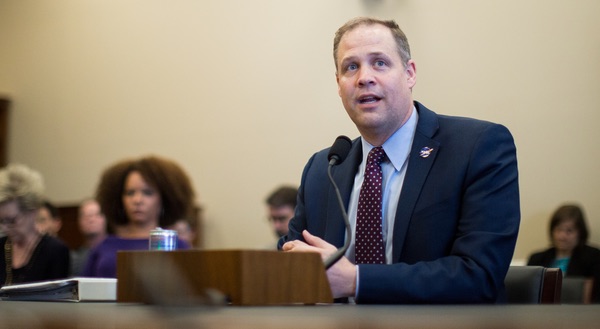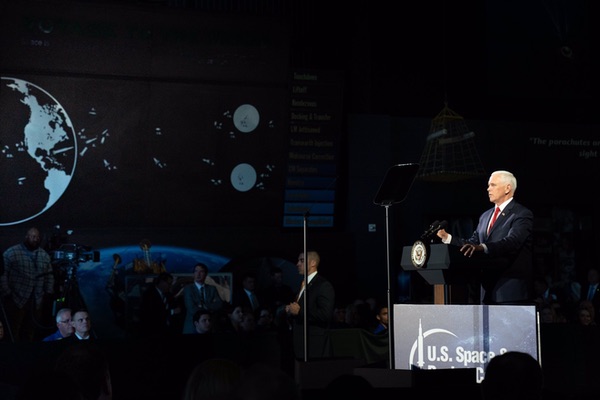Lunar whiplashby Jeff Foust
|
| “Our civil space sector, especially human spaceflight, I think needs a greater sense of urgency,” said Pace. |
It had, of course. The panel took place just a few hours after Vice President Mike Pence, speaking at a meeting of the National Space Council in Huntsville, Alabama, directed NASA to land humans on the Moon—at the south pole, specifically—within five years. That would involve speeding up, if not completely reworking, NASA’s existing plans for getting humans back to the moon.
But Pence’s speech was only the latest in a series of changes over the last month that proposed changes, or in some cases later undid those changes, to NASA’s exploration plans. Those actions have sowed uncertainty across the space community about exactly what NASA plans to do, and how, and for how much.
At the beginning of the month, the plan was similar to what NASA had been discussing for months. Though the first half of the 2020s, NASA would, with international partners, assemble the lunar Gateway in cislunar space, which NASA administrator Jim Bridenstine frequently called a “reusable command and service module” to support lander missions to the surface. Those landings, planned to take place by 2028, would involve a lander featuring separate ascent and descent stages, moved from the Gateway to low lunar orbit with a tug.
But on March 11, the White House releases its fiscal year 2020 budget proposal. For NASA, it called for deferring work on the Exploration Upper Stage for the Block 1B version of SLS. That meant that SLS would no longer be used to launch elements of the Gateway, as previously planned, since the Block 1 version of the SLS won’t have the performance to “co-manifest” Gateway modules along with Orion spacecraft. NASA instead planned to use commercial launch vehicles (or perhaps those from international partners) to launch Gateway elements.
The budget, though, still called for a first SLS launch in 2020. Two days after the budget request was released, Bridenstine threw a curveball: testifying before the Senate Commerce Committee, he revealed that NASA was studying options to use commercial launch vehicles to launch Exploration Mission 1, the next, uncrewed test flight of Orion in 2020 (see “Rethinking EM-1, and SLS”, The Space Review, March 18, 2019).
That led to immediate speculation on what vehicles could carry out such a mission, including claims (for unclear reasons) that SpaceX had an edge. Some even developed artwork showing what a Falcon Heavy launch of an Orion spacecraft would look like.
| “If American industry can provide critical commercial services without government development, then we’ll buy them. And if commercial rockets are the only way to get American astronauts to the Moon in the next five years, then commercial rockets it will be,” Pence said. |
But NASA was backtracking away from a commercial approach to EM-1 almost immediately after that hearing. By the end of that week, Bridenstine said that NASA and Boeing teams were “working overtime to accelerate the launch schedule” for SLS so it could fly the EM-1 mission in 2020. In the week that followed, there were growing, if informal, indications that SLS would be retained to fly EM-1.
The National Space Council meeting on March 26 seemed like an opportunity for NASA to provide an update on those plans. The meeting was billed as an opportunity for provide an overall update on exploration plans and the progress NASA had made.
Before the meeting, officials indicated the council would push NASA to go faster. “Our civil space sector, especially human spaceflight, I think needs a greater sense of urgency,” Scott Pace, executive secretary of the council, said in a March 21 speech at the American Astronautical Society’s Goddard Memorial Symposium. “We’re looking to the vice president to providing guidance on that charge at the next meeting.”
Pence speaks
That guidance came in loud and clear. “You know, after years of cost overruns and slipped deadlines, we’re actually being told that the earliest we can get back to the moon is 2028,” Pence said in a speech that opened the meeting. “Ladies and gentlemen, that’s just not good enough. We’re better than that.”
He argued that the technology needed to carry out human missions to the Moon was available now. “What we need now is urgency,” he said, in part to combat perceived competition from China and Russia. “But it’s not just competition against our adversaries. We’re also racing against our worst enemy: complacency.”
Then Pence provided that urgency. “At the direction of the President of the United States, it is the stated policy of this administration and the United States of America to return American astronauts to the Moon within the next five years,” he said.
He suggested that all options were open to carrying out this goal. “You must consider every available option and platform to meet our goals, including industry, government, and the entire American space enterprise,” he said. “If American industry can provide critical commercial services without government development, then we’ll buy them. And if commercial rockets are the only way to get American astronauts to the Moon in the next five years, then commercial rockets it will be.”
That appeared to be a shot at SLS and Boeing. “If our current contractors can’t meet this objective, then we’ll find ones that will,” Pence said, which again appeared to be aimed at Boeing and its problems with the SLS core stage.
| “Will we meet a June of 2020 launch date? I don’t think that’s in the cards,” Bridenstine said of EM-1. “But I do think we can accelerate significantly from where we were originally told that that launch date would occur.” |
Pence, in the home city of the Marshall Space Flight Center, the lead center for the SLS, was careful to praise the center itself. “This president, this administration, and the American people are committed to achieving that goal at the Marshall Space Flight Center,” he said, later saying that Huntsville would be the place “where America will build a new generation of rockets that will carry American astronauts back to the Moon, on to Mars, and to worlds beyond.”
 NASA Administrator Jim Bridenstine offered few additional details in testimony before House appropriators March 27. (credit: NASA/Joel Kowsky) |
Bold goal, few details
Bridenstine, speaking at the council meeting shortly after Pence, expressed his support for that goal. “You have given us a charge today and it is right on time,” Bridenstine told Pence. “NASA is going to do everything in its power to meet that vision, meet that deadline.”
The goal, though, was followed by few specifics, by Bridenstine or others at the meeting. “Administrator Bridenstine told me, five minutes ago, we now have a plan to return to the Moon,” Pence said. But what exactly that plan is remains unclear: Bridenstine didn’t discuss the plan at the council meeting or, a day later, a previously scheduled hearing by a House appropriations subcommittee on NASA’s budget proposal.
At that hearing, members asked about elements like the EUS, which the budget proposal delayed indefinitely but now appears to be a priority. “If we’re going to have boots on the moon in 2024, as the vice president indicated yesterday and which I believe we can achieve, we’re going to need SLS, and we need to accelerate it and get as many of those as soon as possible, and we’re going to need Exploration Upper Stage as soon as possible,” Bridenstine said. “2024 is a very aggressive schedule.”
Bridenstine was responding to a question from Rep. Charlie Crist (D-FL), who followed up that statement with a question: “So, I assume that all means that we would need more funding in order to accomplish those goals?”
“Yes,” Bridenstine responded, without elaboration.
He did go into details about earlier questions on the SLS schedule. A 45-day study is underway, he said, to look at various changes to cut months from its schedule. Among those potential changes include switching from vertical to horizontal assembly of the SLS core stage and doing away with the “green run” test where the core stage, and its four RS-25 engines, is fired for a full eight-minute mission on a stand at the Stennis Space Center.
Bridenstine, though, didn’t guarantee that would allow a June 2020 launch for EM-1. “Will we meet a June of 2020 launch date? I don’t think that’s in the cards,” he said. “But I do think we can accelerate significantly from where we were originally told that that launch date would occur, which could be a slip of almost a couple of years. I think we can accelerate well ahead of that.”
He also explained that the agency discarded flying EM-1 on commercial vehicles—something he acknowledged in passing at the council meeting, suggesting it could be used later—because of cost and schedule. “While some of those options are feasible,” he said, “none of those options are going to keep us within budget and on schedule.” Earlier, Rep. José Serrano (D-NY), chairman of the appropriations subcommittee, suggested a switch to commercial vehicles could cost an additional $1 billion.
The hearing, though, provided few details about how humans could land on the moon by 2024. Bridenstine’s prepared opening statement, submitted in advance of the hearing, and likely before the council meeting the previous day, made no mention of the 2024 goal. “We are moving fast; we are incentivizing speed, and we are going to start taking ‘shots on goal’ almost immediately,” the statement, posted online, says. “We look to land humans on the Moon within a decade.”
During an hour-long town hall meeting for NASA employees April 1, completed as this article was being prepared for publication, Bridenstine again offered few details about the plan, other than there is a wide-open trade space of options to achieve the goal. “Nothing is off the table,” he said several times during the meeting.
As for funding, he emphasized the support NASA had from within the administration, and the need to build that support with Congress in order to secure the (unspecified) funding needed. “We’ll need additional means,” he said. And maybe additional details, too. The sooner, the better, before those plans change again.
Note: we are temporarily moderating all comments subcommitted to deal with a surge in spam.
